
The responsibility of the set decorator is to create the background of the action with dressing elements that resemble real life. However, in Foundation, now in season 2 on Apple TV+, much of the décor is steeped in science fiction, barely similar to anything that looks remotely like this world. That was the attraction for set decorator John Neligan, who, with his 30 years of experience working in film, television, and commercials, prefers to immerse himself in a new creative vocabulary to enhance the set’s visual action.
Describing the plot for non-sci-fi enthusiasts is challenging, but we’ll give it a go. Based on the award-winning novels by Isaac Asimov, the second season fast-forwards more than a century, with even more tensions mounting throughout the galaxy. With the Cleons’ Brother Day, portrayed by Lee Pace, and his brothers Dawn (Cassian Bilton) and Dusk’s (Terrence Mann) 600 years plus of ruling lying in the balance, a plan is hatched to end the clones of Cleon by proposing marriage to a vengeful Queen Sareth (Ella-Rae Smith), who only wants to destroy the Empire.
Below The Line spoke with John Neligan via Zoom video from Troy Studios in Ireland, who was back to the scene of the crime as much of the sets for Foundation were built there. Ireland is also where Neligan was born and raised, so any time he gets to return and spend time with his family is a plus. He talked about his career path as a “set dec,” the affectionate abbreviation given by his UK colleagues.
In the elaborate world of Foundation, it takes a village consisting of an extensive art department to create what you see on screen. Working closely with draper Jo Roberts and model maker Paddy Hoyne, he discussed dressing practical sets such as Hari Seldon’s (Jared Harris) office, which was built in a church in Tenerife in the Canary Islands, as well as dressing an opera house where Brother Day makes his Imperial speeches. Neligan discussed how he accessorized these various worlds from the interior to the exterior.
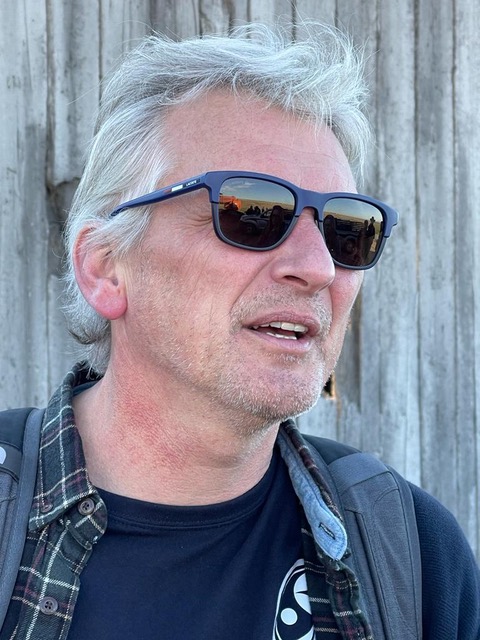
Below The Line: What’s it like to be back in Troy Studios?
John Neligan: Weirdly enough, I’m back in Troy Studios, where it all began. The first time back here since Foundation, obviously. We shot all of the palace stuff here, then went to Spain for all the Terminus stuff, then over in Port Aventura, and I did La Gomera (in Spain), and then Prague took over from there. I’m just doing a small movie here now. It’s medieval and a bit different. So yeah, back to Limerick.
BTL: Tell me how you got onto this career path of set decoration.
Neligan: I worked as a stockbroker, weirdly enough, after I left school in London. I didn’t feel like an office life was for me. So I then went to California for a couple of years, didn’t work in the industry, but came back and started on Michael Collins as a researcher sort of runner and then basically worked my way up over 30 years.
BTL: But why this career? What is it about this profession that attracted you?
Neligan: I’ve been watching movies since I was a kid. I remember when I was much younger going to visit an uncle in L.A. and being in a store off of Sunset Boulevard, and there were a couple of guys there in a toy store trying to figure out where the things they were using could work in a movie. I was fascinated by listening to that. So I always had an ambition to do it—to work in the art department—and I think set design just kind of came naturally.
BTL: What was your first sort of big break as a set decorator?
Neligan: I did two seasons of Ripper Street about 10 years ago. I’d worked with a designer, Steven Daily, for a year. I’ve been sort of set decking for him, but not title. Then we did two seasons of Ripper Street back-to-back, and he asked me to do those. So that was my first introduction to sort of bigger jobs. I’d always set December for smaller stuff. That was the first big, interesting one that I did.
BTL: So how did you get the gig with Foundation?
Neligan: I just interviewed for it. I wasn’t the first set dec. I came on as an assistant, but then Libbe Green was the original set decorator, and she had to go back to the States. So (production designer) Rory (Cheyne) asked me to step up. I’d done sci-fi before with Night Flyers, again in Troy, so it wasn’t an overwhelming proposition. I had been on Foundation for three months at that stage, and I’d done all the original Terminus that we did in Iceland. We did the first iteration of Terminus in Iceland in October or November of 2019. I think we filmed it in November, which was rather cold filming in Iceland in November and trying to dress sets in thermals and gloves and everything like that. So that was sort of tough going. Then I came back over and took over the entire project in January.
BTL: Having done sci-fi before, is dressing a sci-fi set different than other film sets that you’ve worked on?
Neligan: Remarkably, because of sci-fi, you’re looking forward, so there’s no template as such. It’s everybody’s imagination as to what things will look like in the future. If you’re doing Victorians, Vikings, or whatever, all the research is there, and the pictures are there. Sci-fi: you’ve basically got a blank screen.
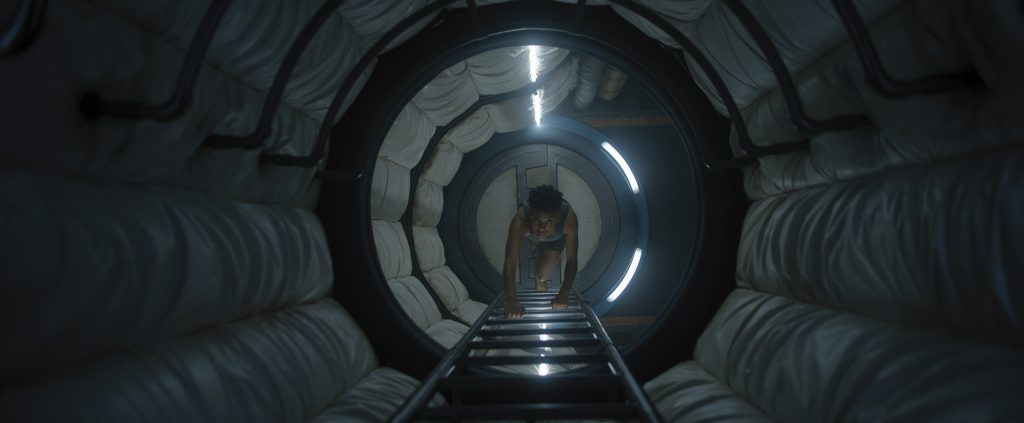
BTL: Who do you collaborate with mostly when decorating the sets?
Neligan: I’m a very collaborative set decorator, so I would work a lot with my prop master, my model maker, and my draper, and at the start of a set, we would all get together and bounce ideas off each other. I would take on board all people’s visions, ideas, and things like that. It was a very collaborative show. I mean, from a drapers point of view, at one point, I think we had 12 drapers full time. For Deliverance (the ship to carry Hari Seldon and his Foundation to colonize the planet Terminus), we draped probably the size of half a football field in different types of fabrics. The whole roof was draped upwards with more than 10,000 fabric samples gathered.
We had incredible drapers, Jo Roberts and her team. I know the Deliverance is quilted. We quilted the roof. We quilted the walls. We quilted the exterior. It was an incredible feat of work. But things you probably wouldn’t even notice because they’re so ingrained in the sets that they just look so natural. Then with model makers, Darragh (O’Loughlin) and his team just knocked out 15 3D printers, CNC machines, everything. They would make everything, and very often it’s easier to make something than to find it and alter it.
For a set like Queen Sareth’s room, I would say we fabricated and made 90 percent of what was in there. There were a couple of chairs that we bought. We were getting to that stage where, hey, if we can imagine it, if we can find a reference we like, and something like that, we’ll just build it.
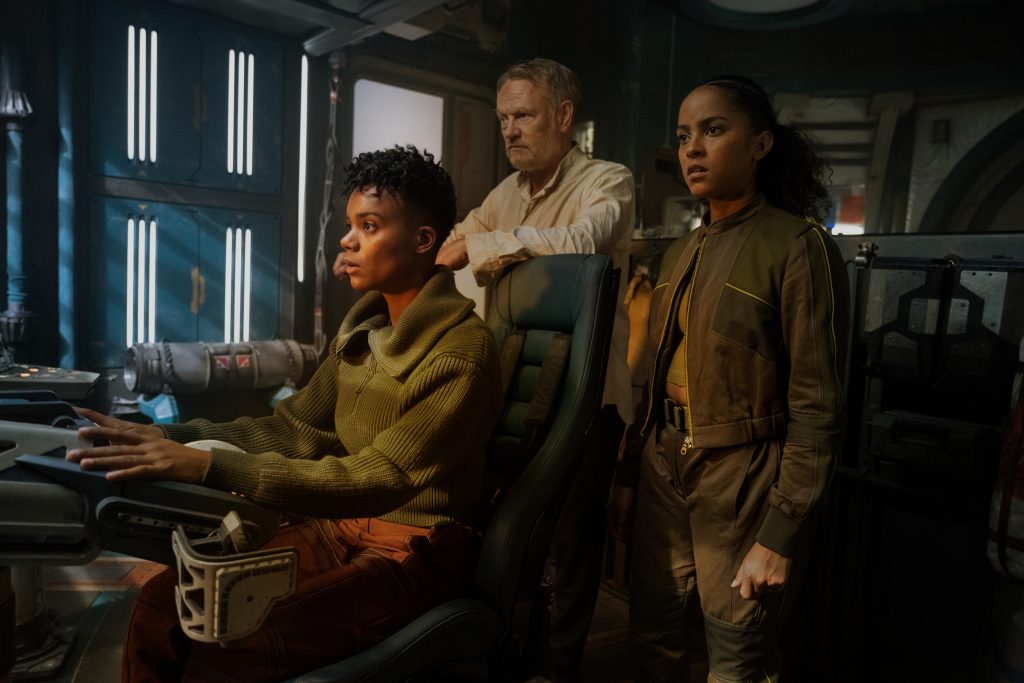
BTL: How did you dress the Beggar’s Lament?
Neligan: That is the cockpit of the Beggar’s Lament. We built the beggars, the corridor, the lock, and the storage area. And then in Prague, they added on a sort of dorm area. So the beggars—yeah, we did everything in there. We manufactured the seats, the steering columns, and there were screens overhead and a lot of padded drapery in there. That was probably a four-week dress; Simon Boyd and props basically spent four weeks layering it. We made all the packaging, the floor, the roof, and everything like that. That was a tough set. It’s one of the main sets. It was Hugo’s (Daniel MacPherson) original spacecraft, which he then gave to Salvor (Leah Harvey), and then it goes through the show. That one took a lot of time and effort.
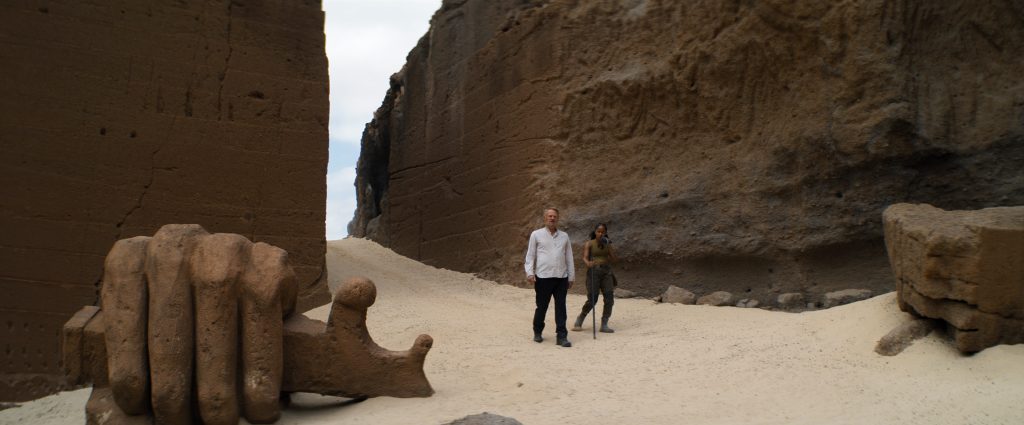
BTL: Describe the sands of this location. Where was this shot and what was added by the set decoration?
Neligan: That is down in the sands of the south of Port Aventura. The hand there was manufactured, not by us but by the prop sculpting team. That was just desert. What you see in the back there is that we brought down a whisper-ship (jumpships developed by the Foundation) ramp, which was the set of the island. It was a very, very difficult location.
I think Marvel and Star Wars have finished there. You kind of lost the horizon. It was an incredible location, and that’s where the stone-eaters were. We built the claws of an ancient stone eater coming out of the ground, which were sort of about 15 feet high. We made those and then brought them down, and somehow the prop guys managed to stand him up in the sand. I think there was a fair amount of VFX there.
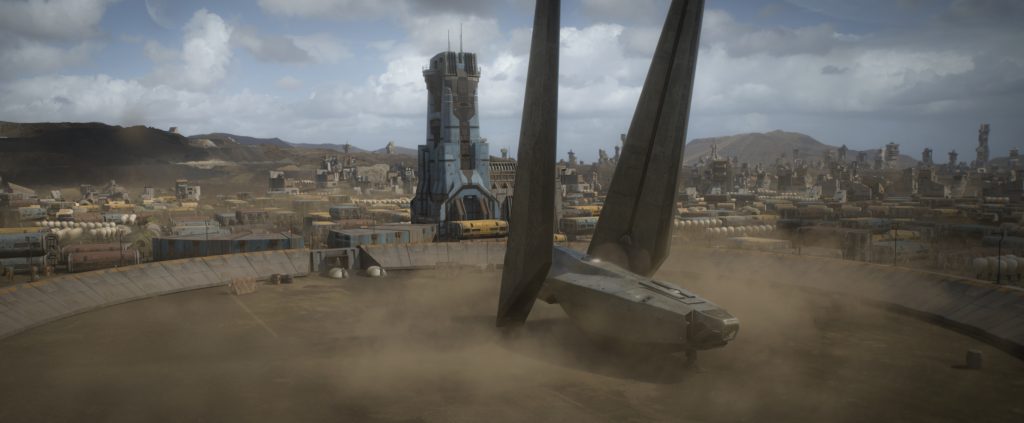
BTL: What did the Terminus set require?
Neligan: It was a massive set of probably three or four acres of just buildings. We added quite a bit to it in season two with the warden’s quarters, the Four Moons Pub, and things like that. So that was quite a bit. It took an awful lot of work to bring that back to life because we basically didn’t pack it.
At the end of season one, we wrapped all the containers around it and left. [chuckles] So, and then it came back. It got a year later when Port Aventura was called the island of strong winds. I think it’s great for windsurfing and all that sort of stuff, but it’s not great for leaving a set for a year! So there was a fair bit of damage to repair when we got there.
BTL: What about the set decoration of Hari Seldon’s office? How’s his space evolve?
Neligan: That was established in season one, and it hasn’t changed. They built that set in Prague. It was in a church called Christ the Redeemer in Tenerife, which is the most spectacular. It’s a relatively new Catholic church, but it’s brutalist architecture—it’s concrete—and so that became his office. I would have sent that to Tenerife, but it’s a continuation of his office from season one. I presume it will go through the show with him. There was not a huge amount to do there because the architecture lent itself so fantastically to what we were looking for.
We would have added his desk, chairs, and a fair amount of candles. His whole library bookshelf space was behind that, which we had to make in such a way that it would fit over the altar of the church so it didn’t look like a church. There was some side chapel behind it, so we put in shelves, candles, and other things in there as a sort of shoot-off room. Then, at the back of the church, we made a cover for the baptismal font, which turned it into a sort of large flambeau. It was a great location to shoot in because it was all of the world without needing too much help.
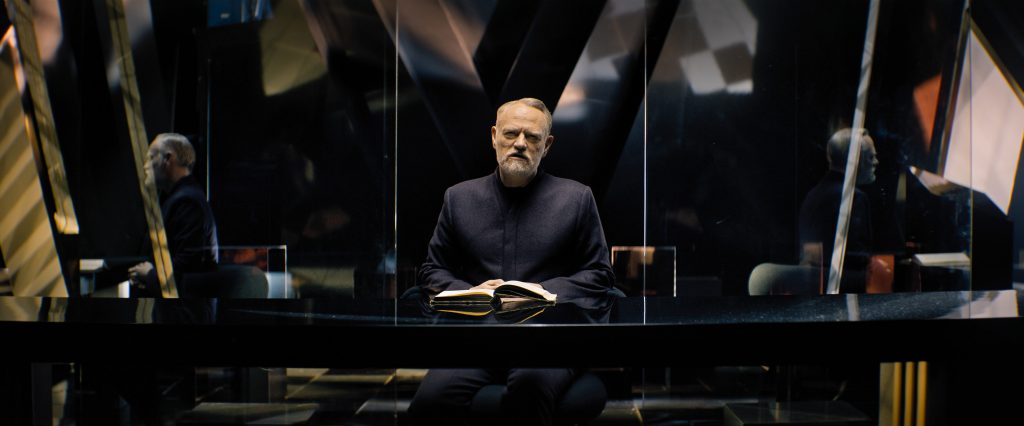
BTL: How do you enhance the sets to pronounce the action so to speak?
Neligan: You speak to the designer about what we want to achieve with it, but sci-fi, I suppose in Foundation terms, we didn’t do a huge amount. You let the big architectural pieces that Rory would have built talk. If you look at Dune 1, there’s not a massive amount of set design, but huge, incredible sets without needing too much help because the set sort of tells its own story. Then it’s what you put in there, and you make absolutely sure it fits, it’s right, and it feels right.
BTL: This project must’ve been such a change from doing the set dec for Peaky Blinders, right?
Neligan: Yeah, I did the 4th season of Peaky, so it had a very established vernacular, and you didn’t want to trail too far off that. It was a show I’d watched, so by the time you actually did it, you had a fair idea of what you’d like to do. That was fun. The director was an old friend of mine from when we were much younger, Dave Caffrey, and the designer, so it was actually great fun to do it, completely different from Foundation. I probably prefer sci-fi, because it’s more creative.
BTL: Do you have another sci-fi project in the works?
Neligan: I’m going on to do a horror movie, which is just shooting in an old castle in the south of Ireland. I’m actually prepping for that in the evenings. Then I’m going to take a break and see what next year brings. I’ve been away a lot, traveling a lot, in the last couple of years, so my wife would appreciate it if I stayed in Ireland [laughs].
BTL: Because this job takes you away from home so much, what’s most rewarding?
Neligan: Personally, it’s working with the team I get to work with. It’s getting up, going and talking to friends, and the whole creative process from Barry the prop guy, who would meet regularly every week and just say, “Where can we go with this? How far can we push this? What can we make work? What can we do differently?” There’s nothing established. We can go where we want. That’s why I really like sci-fi more than anything else. You’re not constrained. Whatever you do hasn’t been done before, and there’s no one to say it can’t be done or that it’s not right. You have the leeway to go where you need to go and where you want to go.
Foundation is now available to stream on Apple TV+.





